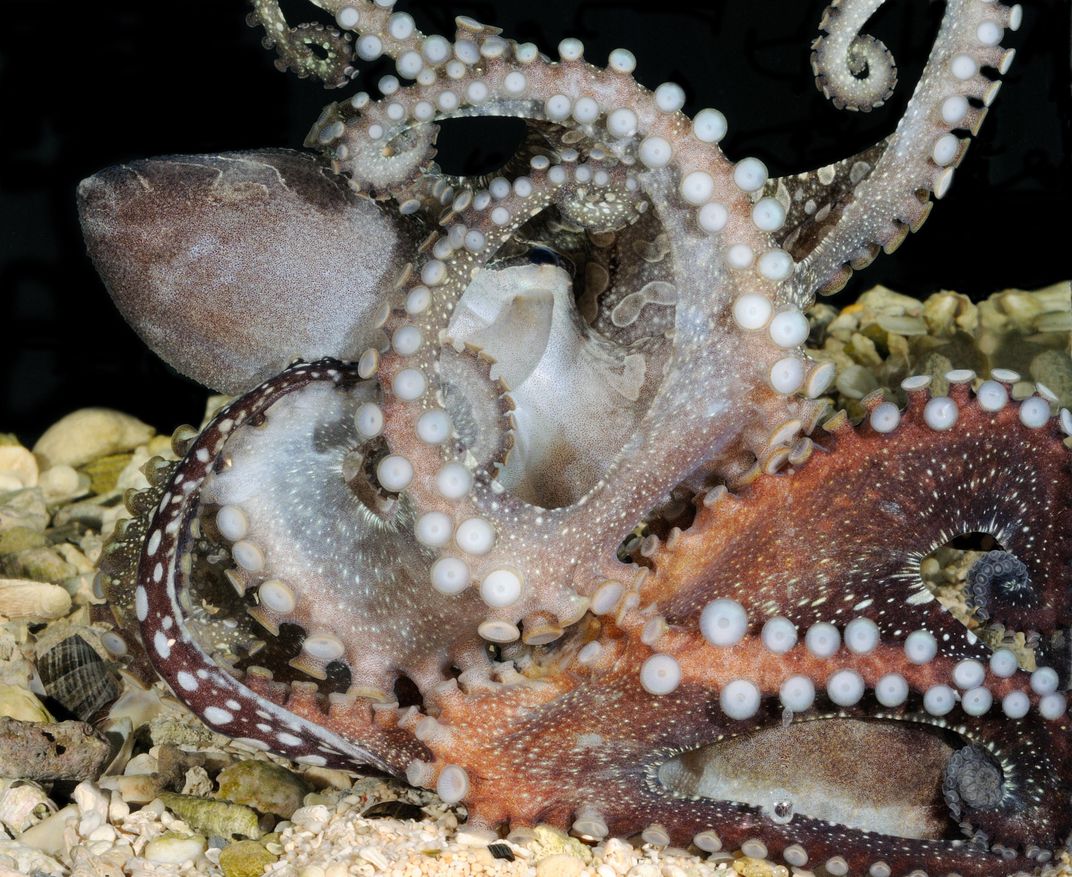Tropical Octopus Definitely Mates Beak-to-Beak
Larger Pacific striped octopus couples engage in a host of behaviors unheard of among other octopuses
/https://tf-cmsv2-smithsonianmag-media.s3.amazonaws.com/filer/bf/82/bf82304a-ec9c-40de-b9d8-63381cc596ac/octopus.jpg)
In 1977, scientific divers discovered an enigmatic cephalopod in the Eastern Pacific, off the coasts of Nicaragua and Panama. Specimens brought back to the lab exhibited a host of strange behaviors never before observed in an octopus, including beak-to-beak mating, couples that shared dens and inking during mating. But these intriguing observations were just too weird for scientists at the time—many rejected a formal description of the species, and for decades the larger Pacific striped octopus was all but forgotten.
Now, the bizarre beast has been dragged out of hiding once again. After two years of study, a team of marine biologists from the University of California, Berkeley, the California Academy of Sciences, the Smithsonian Tropical Research Institute and the Monterey Bay Aquarium has managed to confirm many of the octopus’s unique behaviors. While the team has not issued a formal description of the animal, they believe that their observations, published today in PLOS ONE, provide a basis for finally giving the Pacific striped octopus its due as a full-fledged species.
In 2012, the researchers learned that a wholesale aquarium trade collector had managed to trap 24 larger Pacific striped octopuses in the shallow waters off the Nicaraguan coast. Within a week of capture, the octopuses arrived at the researchers’ lab at Berkeley. Like other octopuses, the animals could change their skin color, although they usually stuck with some version of brown and white bars and stripes. And despite the informal name, the larger Pacific striped octopuses were tiny, with mantles measuring just about an inch long.
Fearing cannibalism, the researchers at first kept all of the octopuses separate. When tentative matings resulted in no damage beyond a few overly enthusiastic sucker marks, the researchers paired the octopuses up in tanks. Each enclosure contained shelters that could serve as octopus dens, including large shells, flowerpots, bottles and PVC tubes.
Some females and males chose to share a den. When this happened, the amorous animals mated daily. In almost every case, the octopuses mated facing each other, sometimes with their suckers aligned. During these sessions, the female turned a pale white while the male opted for darker coloration. The females often wrapped the males in an eight-armed embrace, sometimes nearly enveloping their smaller partners. Males occasionally inked while in the throes of their partner’s grip, while females tended to jet water at the males.

Face-to-face mating in the animal kingdom is rare but does occur, including in most primates, seahorses and some whales and dolphins. Certain squids and cuttlefish—close relatives of octopuses—also face each other when mating, but this is the first time researchers have confirmed such a behavior in an octopus. Indeed, the technique of enveloping its partner in a tentacled bear hug is reminiscent of aggressive rather than loving gestures seen in other octopuses.
The researchers do not know why face-to-face mating developed in the larger Pacific striped octopus, but they suspect it might be advantageous to females that are guarding eggs, or to males that wish to monopolize a female’s time and prevent her from courting two suitors at once, as some octopus species do.
The animals stood out in other respects, too. For example, females continued to accept their mates even after their first brood of eggs hatched. Such cases of extended spawning are rare among shallow-water octopuses. Occasionally, mating pairs shared food, sometimes eating in the beak-to-beak position—another strange behavior by octopus standards. Finally their method of hunting was also unique: they extended a tentacle over a shrimp and, like a human prankster, tapped the animal on the opposite side, tricking it into fleeing directly toward its eight-armed doom.
The authors argue that all signs point toward a new species, and that a description will likely be forthcoming in the literature. But they note that understanding the unique behaviors observed in the lab and confirming that they also occur in nature will require donning scuba gear and undertaking some voyeurism of the species in its natural habitat.
/https://tf-cmsv2-smithsonianmag-media.s3.amazonaws.com/accounts/headshot/Rachel-Nuwer-240.jpg)
/https://tf-cmsv2-smithsonianmag-media.s3.amazonaws.com/accounts/headshot/Rachel-Nuwer-240.jpg)